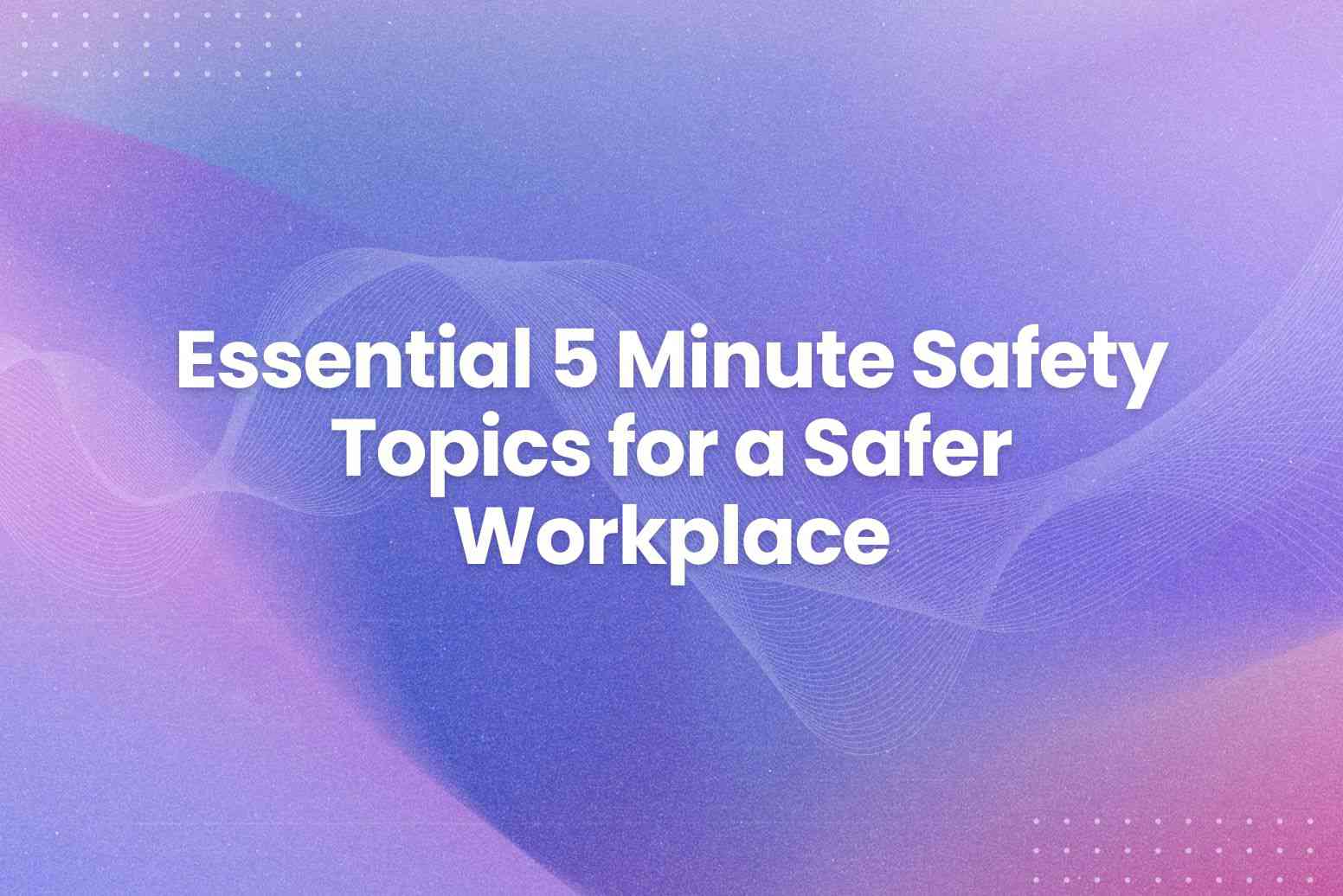In today’s fast-paced work environment, safety should be a paramount concern for both employers and employees. However, creating a culture of safety doesn’t have to be time-consuming or complicated. Enter 5 minute safety topics—brief yet impactful discussions that can be easily integrated into your regular routines. This guide will cover essential 5 minute safety topics and key points for effective implementation. By promoting awareness and implementing best practices across various safety topics, organizations can create a safer workplace, enhance productivity, and demonstrate a commitment to employee well-being.
Read also: Ultimate Guide & Example of Crucial Leadership Topics

What Are 5-Minute Safety Topics?
5-minute safety topics are brief, focused discussions or presentations aimed at educating individuals about specific safety issues, risks, or best practices. They are typically designed to be informative yet concise, making them suitable for quick meetings, training sessions, or informal gatherings in workplaces, schools, or community settings.
The topics can cover various subjects, including:
- Hazard recognition
- Emergency procedures
- Health and safety regulations
- Personal protective equipment (PPE)
- Safe work practices
- Accident prevention strategies
Why 5 Minutes?
Time-Efficient
In today’s busy environment, people often have limited time to dedicate to training. A 5-minute format allows for quick discussions without significantly disrupting daily activities or routines.
Increased Engagement
Shorter sessions tend to keep participants more engaged. A brief, focused talk encourages attention and retention compared to longer presentations, which may lead to disengagement.
Easier to Digest
Complex safety topics can be overwhelming. Breaking down information into 5-minute segments makes it easier for individuals to understand and remember key points.
Regular Safety Meetings
Organizations can incorporate these short topics into daily or weekly meetings, promoting a regular safety culture without requiring extensive setup or preparation.
Flexibility
5-minute topics can be easily adjusted to fit into various settings and schedules, making them adaptable for training sessions, toolbox talks, or other safety-oriented discussions.
Encourages Discussion
A concise format allows for time at the end of the presentation for questions and discussions, fostering a collaborative approach to safety.
In summary, 5-minute safety topics serve a vital role in promoting safety awareness and practices in a time-efficient and engaging manner, ensuring that important safety information is communicated effectively to all individuals within an organization or community.
How to Choose Safety Topics
Here are four concise tips for choosing effective safety topics:
1. Assess Audience Needs
Understand the specific demographics, roles, and experience levels of your audience. Tailor topics to address their unique safety concerns and knowledge levels, ensuring relevance and engagement.
2. Evaluate Current Hazards
Conduct a thorough analysis of workplace or environmental hazards through inspections and incident reports. Focus on high-risk areas and prevalent safety issues to prioritize topics that can have an immediate impact.
3. Stay Updated on Trends and Regulations
Keep abreast of the latest safety regulations, industry standards, and seasonal hazards. Choosing topics that align with current trends ensures the information is relevant and that the audience is compliant with regulations.
4. Encourage Participation and Interaction
Select topics that promote discussion, hands-on activities, or real-life scenarios. Engaging formats not only enhance learning but also encourage participants to share their experiences and insights, reinforcing the importance of safety awareness.
Fire Safety
Fire safety is crucial for protecting lives and property. It’s essential that employees understand how to prevent fires and respond effectively in an emergency.
- Importance of Smoke Detectors: Regularly check and maintain smoke detectors. They should be placed in every room and tested monthly.
- Escape Plans: Every workplace should have a clear escape plan with multiple exit routes. Employees should know these routes and participate in evacuation drills.
- Using Fire Extinguishers: Employees should be familiar with using fire extinguishers using the PASS method: Pull, Aim, Squeeze, Sweep.
Ergonomics in the Workplace
Creating an ergonomic workspace is key to preventing strain injuries and promoting employee comfort and productivity.
- Proper Workstation Setup: Desks and chairs must be adjusted to fit each employee. The top of the screen should be at or just below eye level.
- Regular Breaks: Encourage employees to take short breaks throughout the day to stretch and change positions.
- Use of Ergonomic Equipment: Invest in ergonomic chairs, keyboard trays, and footrests.
Personal Protective Equipment (PPE)
PPE is essential for preventing injuries in many workplace environments, especially where hazards are present.
- Types of PPE: Include helmets, gloves, goggles, and earplugs, depending on the job requirements.
- Importance of Wearing PPE: Employees must understand that PPE is crucial for their safety and well-being.
- Maintenance and Inspection: Ensure PPE is regularly inspected and maintained.
Slips, Trips, and Falls Prevention
These types of incidents are common but preventable through awareness and proper safety measures.
- Identify Hazards: Regularly assess the workplace for potential slip, trip, and fall hazards.
- Keeping Walkways Clear: All areas must remain clutter-free and well-lit.
- Proper Footwear: Encourage wearing appropriate footwear to enhance grip and stability.
Cybersecurity Awareness
In an increasingly digital workspace, cybersecurity is essential to protect sensitive information.
- Strong Passwords: Emphasize the importance of using strong, unique passwords and changing them regularly.
- Recognizing Phishing Attacks: Train employees to identify phishing emails and suspicious links.
- Software Updates: Ensure all software is regularly updated to protect against vulnerabilities.
First Aid Basics
Knowing first aid can save lives in emergencies. Training employees in basic first aid procedures is crucial.
- Knowing Basic First Aid and CPR: Every employee should know basic first aid, including how to perform CPR.
- Assessment Skills: Teach employees how to assess a situation and prioritize actions in an emergency.
- First Aid Kit Awareness: Ensure first aid kits are stocked and employees know their contents and where they are located.
Workplace Violence Prevention
Preventing workplace violence involves awareness and preparedness. Employees should know how to respond to potential threats.
- Recognizing Warning Signs: Train employees to recognize aggressive behavior or unusual actions in colleagues.
- Reporting Procedures: Establish clear procedures for reporting incidents or concerns about potential violence.
- De-escalation Techniques: Provide training on how to diffuse tense situations safely.
Vehicle Safety and Defensive Driving
Driving safety is critical in preventing accidents and injuries associated with vehicle operation.
- Seatbelt Usage: Ensure all employees are aware of the importance of wearing seatbelts proper child safety seat guidelines.
- Safe Following Distance: Teach employees the importance of maintaining a safe distance from the vehicle in front of them and being aware of their surroundings.
- Avoiding Distractions: Encourage employees to avoid distractions, such as mobile phone use, while.
Chemical Safety
Chemical protocols are essential for workplaces that handle hazardous materials.
- Understanding Safety Data Sheets (SDS): Employees should know how to read and interpret SDS for the chemicals they handle.
- Wearing Appropriate PPE: Ensure that employees are aware of the required for handling specific chemicals.
- Proper Labeling and Storage: Stress the need for proper labeling based on regulations and guidelines, as well as safe chemical storage practices.
Mental Health and Workplace Safety
Recognizing mental health’s impact on overall workplace safety is crucial in creating a supportive environment.
- Impact of Stress and Mental Health: Discuss how stress and mental health issues can affect performance and safety.
- Encouraging Open Conversations: Promote a culture where employees feel comfortable discussing mental health and wellness.
- Resources for Support: Make aware of available mental health resources and support systems within the organization.
Conclusion
Incorporating short, impactful safety lectures into your office routine is an effective strategy to raise awareness and build a safe culture. Prioritizing safety in the workplace requires continuous effort from both leadership and employees. By discussing these key 5 minute safety topics and integrating them into everyday practices, organizations can reduce risks, enhance productivity, and foster a positive work environment.
As we strive to enhance our workplace safety culture, we encourage everyone to harness the power of Arvin, our AI assistant, to streamline hazard identification and risk assessment processes.
FAQs
The best topic for a safety meeting can vary based on the specific context of your workplace, the industry, and any recent incidents or safety assessments. However, a universally relevant and impactful topic is “Workplace Hazard Identification and Risk Assessment.”
Workplace safety talks are short, digestible, pre-work meetings about a particular safety topic that informs the work people are doing that day. These talks are most effective when kept short, focused, and memorable so workers can easily apply the advice right away and recall it over the long term.
Ensure that the talks are scheduled at a time when most employees can attend. You can also provide written summaries or recordings for those who cannot make it.






